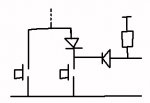GeorgeSmith
New Member
Hello
I am working on a circuit. Here is What I have so far - excuse all the white blocks on the image I deleted all the circuitry that was irrelevant to my question. S1 or S2 turn on the pixaxe. Basically I want to send a signal to the picaxe so it knows which switch was pressed. I was thinking of using a NPN transistor but I need some help.

Thanks in advance
I am working on a circuit. Here is What I have so far - excuse all the white blocks on the image I deleted all the circuitry that was irrelevant to my question. S1 or S2 turn on the pixaxe. Basically I want to send a signal to the picaxe so it knows which switch was pressed. I was thinking of using a NPN transistor but I need some help.

Thanks in advance
Attachments
-
50.8 KB Views: 35



